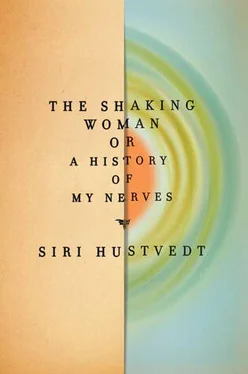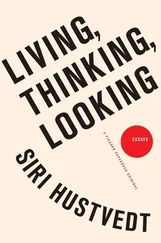I feel I have one — a self — but why? Is it everything that lies within the borders of my body? Not really. When I shook, it didn’t feel like me . That was the problem. When did it arrive, that selfness? I don’t remember, but I know that secrecy is part of it. There was a time when I believed my mother could look into my eyes and see guilt. In What Maisie Knew, Henry James identifies a new sense that has begun to stir in his child heroine:
The stiff dolls on the dusky shelves began to move their arms and legs; old forms and phrases began to have a sense that frightened her. She had a new feeling, the feeling of danger; on which a new remedy rose to meet it, the idea of an inner self or, in other words, of concealment. 189
Maisie discovers the place in us we retreat to, the place where we hide without being seen by others, the refuge we seek when we are afraid, and the dark sanctum that makes lies possible, but also daydreams and reveries and bad thoughts and intense internal dialogues. This is not the core biological self. It comes about at some half-remembered time in childhood. Other animals don’t have it; it requires an understanding of a dual reality, that the verbal or emotional content of an inside self doesn’t have to show itself to the outside. In other words, you have to be aware of what you are hiding to hide it. Very small children often narrate their thoughts aloud. At three, my daughter chattered away as she played: “The little piggy’s going to bed all alone. Whoops, he falls off the bed! Better get back up. Don’t cry, little piggy.” But later, the narration stopped. Sophie could play for hours in silence, absorbed but not talking. Her narrator had gone inside. Is this when a turn is made? Is this inner arena of thought and play what many of us identify as a self? Is it our felt version of Descartes’s Cogito, ergo sum ?
In The Principles of Psychology, Henry James’s older brother, William, develops a broad notion of self or selves that begins with the body of a person, a material self, a Me, which then moves outward to include a wider self — the Mine, which embraces a man’s clothes, his family, his home and property, his successes and failures. Notably, James acknowledges that parts of our bodies are more intimate than others, that a lot of self-feeling — or what he calls “the Self of Selves”—happens “between the head and throat,” 190or from the neck up, not the neck down. In light of this fluctuating self, James makes a distinction between the unsympathetic and the sympathetic person. Using Stoicism as an example of the unsympathetic character, he argues, “All narrow people retrench their Me, they retract it, — from the region of what they cannot securely possess.” 191Sympathetic characters, on the other hand, “proceed by the entirely opposite way of expansion and inclusion. The outline of their self often gets uncertain enough, but for this the spread of its content more than atones.” 192James’s conception of self is elastic — it shrinks and grows depending on one’s personality and from moment to moment in a single person’s life. It might be because the outline of my self is subject to some blur that I lean in the sympathetic direction, that I like the idea that we both take in the world and move outward toward it, and that movement is part of a feeling of my self that includes others. I am not always locked away in the cell of my private, hidden thoughts, and even when I am, large parts of my world are closed in with me — chattering multitudes.
We cannot uncover “a frozen universe of objects independent of all gaze and thought,” but there is an intersubjective world of shared languages, images, reason, and other people, and I do think that greater or lesser openness to those words and pictures and persons is possible. Some people have tight, hard little selves. Others are more open. Some are so open they drown in other people, like the psychiatric patients who confuse “I” and “you.” Nevertheless, there are moments when I find myself lost in you. There are also moments when I look so hard at a thing that I disappear. The internal narrator takes a holiday, leaves me for a while. Actions and words continually confound this narrator, not only in the form of roaming alien hands, flashbacks, seizures, and visual or auditory hallucinations but also in far more mundane events. I find my fingers moving toward the bowl of chocolates before I know they are doing it, or a sentence fragment or melody arrives unbidden in my head. How many times have I met a person and instantly felt something was wrong? It was not through verbal communication that I understood this. Before I am able to articulate the problem to myself, I feel it. Later, I might speculate that perhaps I sensed a stiffness in the other person’s body, which then registered in my own, or saw him glance elsewhere, and that look reverberated in my chest or registered itself as a tightening around my own eyes or an inadvertent movement backward. Mirror-touch synesthesia or not, I am surely not alone. We respond to what is beyond our own bodies with feeling that is prereflective, an embodied meaning. That feeling is conscious surely, but not “hero of my own life” self-conscious. I am not looking at myself feeling.
THE CONSCIOUS SELF’S BOUNDARIES SHIFT. It is a question of ownership, of me and mine. A patient in the neurology ward with damage to her right hemisphere neglects her paralyzed left arm for a week, insisting that it belongs to her doctor. Her physician may tell her that she has it wrong, it’s her arm, but she will not believe it. But then, in time, she comes to understand that the limb is hers. She is able to reclaim it, although an underground part of her has always known that it is hers, and she can’t move the miserable thing. What has changed? Did the truth of her paralysis suddenly enter her consciousness? Can she say, “I now remember that my arm is useless”? One day, after eight long years, Justine Etchevery is able to take back the use of her arms and legs. She wants to walk, and she does. She regains a sense of willed movement: I can walk. What jogged that miracle? Did an unconscious idea of her paralysis suddenly dissolve, one that we could now see on a scan as a vanished asymmetry in her brain? The veteran of the First World War cannot hear or speak until one day his body erupts in spasms and his hearing and speech return. He is able to say, “I can hear, I can speak.” I don’t know whether he could then remember and tell the story of what happened to him in the trench. But I know that telling is not enough. The meaning of what happened to him would have to be felt and recognized as his or it would be nonsense. Anna Freud was the first to use the word intellectualize to describe people who use verbal ideas as a form of defense. A patient talks about his mother’s suicide as a clinical story of her depression and tells it without feeling or affect, in a calm, neutral recitation that should be connected to emotion but has become removed from it. He, too, has la belle indifférence . The shattering loss is kept at a distance; its meaning goes unrecognized because to see it is terrifying. And then, after the back-and-forth of psychotherapy, during which he reflects and is reflected back upon himself through the eyes of his analyst, he senses a change, a new configuration of his consciousness that includes both knowing and feeling. He retells the story, and in the retelling, which is also a reinvention, he feels the undercurrents and rhythms of his lived body. He makes the wrenching loss his own in an act of creative memory; it becomes part of his narrative self. And there are neuronal changes in his brain accordingly, in the limbic emotional systems and the prefrontal executive areas. There are times when we all resist claiming what should be ours; it is alien, and we do not want to take it into the stories we spin about ourselves.
Читать дальше












